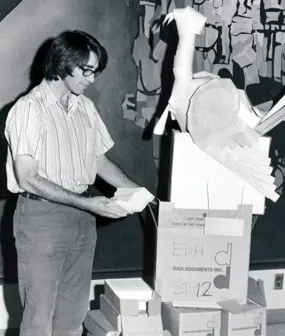When Life Gives You Punch Cards

Most of us are familiar with the proverb, "When life gives you lemons, make lemonade,” used to encourage optimism and a can-do attitude in the face of adversity or misfortune. But what if life gives you 46,000 computer punch cards? You make a turkey, of course, as former OSC students John Hayes, Steve Martinek and Dave Towner did in November 1978.
The raw material was a gift of sorts from classmate Ed Huber who had been working on an optical design problem with the software program ACCOS V. Using a desk-sized keypunch in OSC’s fifth-floor computer workroom, he had painstakingly punched his code line-by-line onto stiff paper cards, which he then fed into a card reader.
The card reader transmitted the code over phone lines to the campus computer center for processing. Normally, the mainframe computer would follow the sequence of instructions in the code, solve the given problem and then send the output back to a printer at OSC. Once the results were returned, Ed could triumphantly retrieve his computer printout. Simple.
Unfortunately, on this particular day — due to the inadvertent omission of an exit card from Ed’s code — the computer “hiccupped.” It instructed the computer center’s keypunch to generate one card after another, each bearing one punched hole, for approximately three hours, until the $177 balance in Ed’s account was depleted.
The next day, an employee from the computer center showed up outside the student cubicles with 23 boxes bearing Ed’s name. Steve, who just happened to be walking by, accepted the delivery on Ed’s behalf.

Curious as to why so many punch cards would have been delivered, and whether they could have been delivered in error, he enlisted Dave and John to help examine the cards in a few boxes. It soon became evident that none contained usable information and they had all been printed by mistake. Presented with this bounty of varying colors, unsuitable for reuse, the three friends “totally sympathetic to Ed’s predicament,” moved the boxes to the computer workroom and went to work to figure out a consolatory “surprise” for their classmate.
Dave picked up a handful of cards and immediately arranged them into a colorful fan. John and Steve, following his lead, formed larger and larger fans. Perhaps inspired by the approaching holiday, they grabbed staplers and began shaping the cards into a large turkey. Once they were satisfied with their creation, they carefully moved “Tom,” perched atop a few unopened boxes, to professor Bob Shannon’s optical engineering class, where they later presented a somewhat baffled Ed with his costly Thanksgiving turkey and the “Optical Sciences Black Card Award.”
Incidentally, upon graduation, Dave Towner went out into the world with not only a “broad foundation in all areas of optics,” but also with a love of sculpting animals. As a brief interlude from his optical design career, Dave sculpted scale models of marine mammals. During this time, he worked in collaboration with naturalist and filmmaker Al Giddings (“The Abyss,” “Titanic”) as part of an ABC World of Discovery documentary “Blue Whale: Largest Animal on Earth,” which aired December 1995. Coincidence or fate?
(I just have to wonder what would have happened if Ed Huber’s computer account balance had been more substantial: would Dave, with help from his friends, have created his first whale back at OSC in 1978?)
